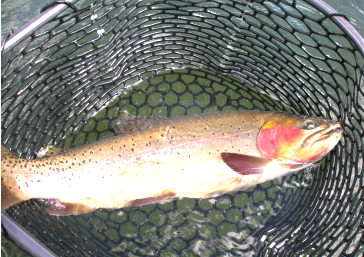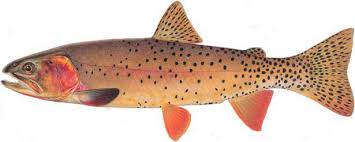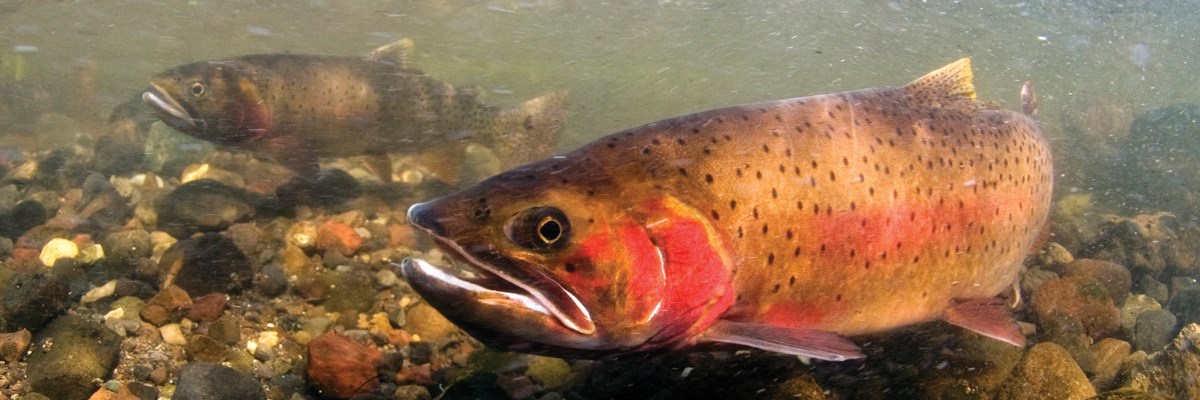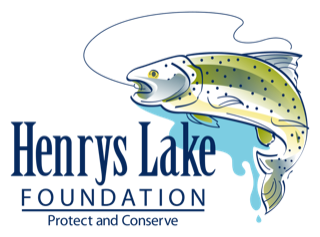The Fish

The Yellowstone strain of cutthroat trout is the native species in Henrys Lake, Idaho. Henrys Lake Cutthroats have been naturalized to Henrys Lake since the end of the last ice age over 9,000 years ago. They have gained access to Henrys Lake from the Henrys Fork of the Snake River through the main Snake River before Shoshone Falls (near Twin Falls, Idaho) was formed and became a fish migration barrier. Cutthroats have thrived in Henrys Lake and they are the stronghold of cutthroat trout in the Henrys Lake watershed.
The Fishery
Today the Yellowstone cutthroat trout provide an exceptional fishery in Henrys Lake. They comprise approximately 65 percent of the catch on the lake and average over 17 inches in the creel. They can grow as large as 7 pounds and attain an overall length of around 25 inches. This is a feisty cutthroat that is prized among anglers for its beautiful coloration, fighting ability, and its catchability.

The Cycle Begins With Fry
Cutthroat spawn in the tributaries to Henrys Lake and prior to the building of the Henrys Lake Dam in 1922, the lake fish spawned in the outlet of Henrys Lake, the headwaters of the Henrys Fork of the Snake River. Cutthroats ascend tributaries in May and June to spawn. They can remain in the tributaries and spawn through July, and although spawning mortality is significant, the surviving fish return to the lake and may repeat the spawning process a year later. Rarely do the Henrys Lake cutthroats spawn more than two times. The eggs that are deposited in suitable gravel develop and hatch. The fry that hatch from eggs spend a short time in the streams but migrate down to the lake. Migration to the lake from tributaries occurs from July through October. The peak of fry migration occurs from July-September in most years.
Life Begins in the Lake
Upon reaching the lake, cutthroat fry seek out the protection and cover of the variety of water plants, known as aquatic macrophytes. Within the jungle of aquatic macrophytes, fry find food in the form of plankton, tiny insects, aquatic worms and fragments of larger organic material. Mortality is high on the fry because many animals and even insects can prey upon the tiny fish. The cutthroat of Henrys Lake are very important to a variety of fish-eating birds that include coot, golden-eye, grebe, merganser, loon, kingfisher, white pelican, osprey, and bald eagle. Mink, otters, weasel, skunk, fox, coyote, Black bear, and even grizzly bears are mammals that are also very dependent upon cutthroat trout. The fry thrive and grow fast in Henrys Lake because of the abundance of food and overall favorable conditions in the lake. Fry are classified as fingerlings once they reach 3 inches in size and fingerlings become catchable trout. Cutthroats begin to be caught by anglers when they are about a year and a half old. They are sexually mature and capable of spawning at 3 years of age although some may spawn at 2 years. The cutthroat generally live to be 4 years old but a few live to be around 6 years old. Mortality rates have been estimated at over 50 percent per year among catchable fish. However, most of the mortality is due to natural causes and not a result of fishing or angler harvest. Exploitation or the percentage of the fish population that is lost annually due to angling has been estimated at less than 5 percent.

Spawning
The fish that are mature begin assembling at the mouths of streams to spawn as soon as ice cover leaves the lake, usually in early to mid-May. This may occur even prior to ice off at spring creeks, such as Howard Creek. When the temperature and flow conditions are right in the stream the fish begin moving upstream. The female cutthroat will select a place in the stream that appears to have the proper flow characteristics, gravel size and porosity of gravel. She will determine this by digging in the gravel with a rapid swimming motion of her tail. The female cutthroat can test several areas before settling on the best place to produce a nest or redd. The redd is a depression excavated in the gravel through the rapid swimming motion of the female cutthroat. The digging produces a pile of gravel above and below the redd. This piling up of gravel also acts to clean the gravel of silt and debris. After the redd is constructed the female will remain near the excavation until a suitable male comes along. There may be several male cutthroats that compete with each other to spawn with the female. They compete by aggressive displays to ward off the lesser suitors and will chase, bite, and ram other male fish until they leave the area or move a safe distance away. Eventually, the female fish ripens and with a male fish alongside, deposits eggs into the bottom of the depression or redd. As the eggs are deposited the male fish exudes a milky cloud of sperm called milt. This quickly fertilizes the eggs as they fall to the bottom of the redd. The female then goes upstream and through a rapid swimming motion suspends the gravel, that was previously piled up in the excavation of the redd, to settle gently over the eggs creating a king of gravel pillow over the eggs.
The Renewal of Life
The eggs begin hatching after several weeks but the newly hatched trout remain in the gravel until they absorb their yolk sac. This is a source of nutrition for the fish as they continue to develop. After the yolk sac is absorbed they emerge from the gravel and begin feeding on microscopic diatoms, tiny insects and fragmented organic material carried by the stream. Before long, they begin their journey back to Henrys Lake, and the cycle of life for the Henrys Lake cutthroat begins anew.
Hatchery Supplementation
Every spring, hatchery personnel spawn over 1000 pairs of pure cutthroat trout and harvest over 2.5 million eggs from this spawn take. After approximately 1 month of development, the eggs are shipped to the Mackay hatchery where they are hatched and reared. In September of the same year, the fingerlings are returned to Henrys Lake via semi-truck and trailer and released into the wild. Approximately 1.3 million cutthroat fingerlings are released in Henrys each year from this hatchery supplementation plan. The cutthroats grow quickly and a year later, anglers are busy catching these same fish. Hatchery supplementation is carried out at Henrys to create greater and more consistent catch rates at this popular fishery. However, protecting the natural spawning contribution and habitat is of critical importance and hundreds of hours are spent annually maintaining riparian fencing and fish screens, and monitoring natural spawning production. Henrys Lake is a stronghold for the Yellowstone cutthroats and maintaining and improving habitat conducive to successful natural production is a focus of private and public entities.
Resources: NPS.gov, USDA Forest Service
